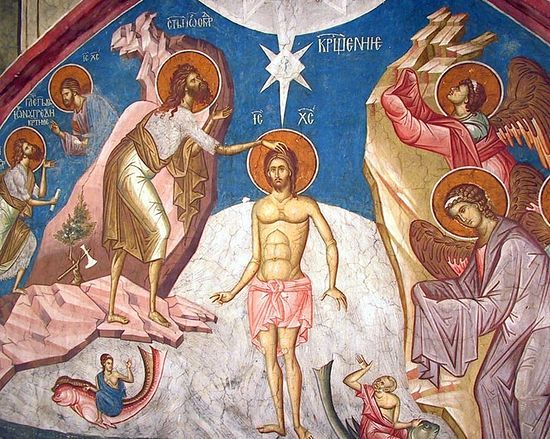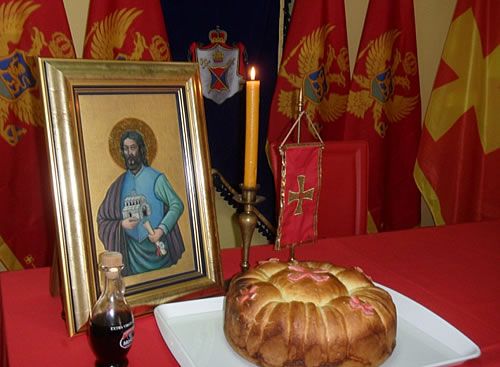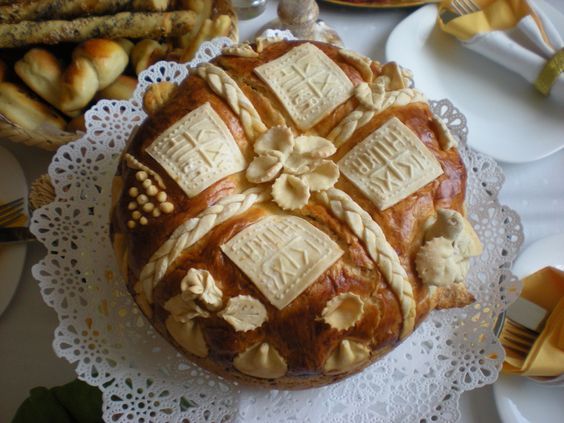The name of the holiday itself sounds very Slavic, and it literally means „celebration,“ i.e. a major holiday - and it is actually the essential holiday throughout the year which is celebrated much more than, for example, New Year's Eve or a birthday. To Montenegrins, Krsna Slava is the most solemn day of the year and it celebrates the spiritual birthday of their family.
Christianity in Balkans was accepted collectively by families and by tribes. In commemoration of their baptisms, each family or tribe began to celebrate especially to honor the saint on whose day they received the sacrament of Holy Baptism. Common to young religions, the new custom was actually a reinterpretation of a pagan rite: the tribe's ancestor-protector became a Christian saint, so the church happily blessed this practice and proclaimed Krsna Slava a Christian institution. The tradition has its origin in Medieval Serbia and is recognized today as a distinctly (if not entirely exclusively) Serbian custom, though it is also practiced by Orthodox Macedonian families, Orthodox and even Catholic Montenegrins.

It's interesting that the family saint is inherited from father to son, while women do inherit the patron saint of their husbands upon leaving their families. This family's annual ceremony is an important social event in which the family is together at the house of the patriarch. And today, it is quite common even for nonobservant Christians to celebrate it in one form or another as a hereditary family holiday.
In Montenegro, many saints are considered family protectors, but the most popular among them is St. Nicholas (Nikoljdan, 19 December), St. Arch.Michael (Aranđelovdan, 21 November), St. John the Baptist (Jovannjdan, 20 January), St. George (Đurdjevdan, 6 May), St. Sava (Savindan, 27 January) and St. Petka (Petka, 27 October). Coming from small groups with close inside relations, locals attach high importance to Slava day as a mark of tribe identification.

The celebration is supposed to last for three days as wealthy families used to do in the old times; however, an accelerated tempo of life shortened this holiday even in Montenegro. The ritual of the Slava celebration traditionally includes:
- An icon of the family's patron saint which used to be placed in the most visual place in the house
- A lit candle, for Christ the Light of the World
- A boiled wheat dish (Slavsko zhito/koljivo), representing Christ's death and resurrection
- White wheat round bread (Slavski kolach/Krsnjak), decorated with a cross, dove and seal, for Jesus Christ the Bread of Life
- Red wine, for Christ's precious blood that washes away sin
- A priest, who blesses the house and all present and cuts the bread crosswise pouring wine on it

After the religious rite, the celebration continues at the rich table and ends late at sunset. Festive treats differ from village to village and from one saint's day to another, but one thing remains unchanged – there are always the most delicious dishes on the Slava table: baked and boiled meat (or fish during a period of fasting), soup, prsut, young cheese, olives, salad mix, choice of cakes, and of course, homemade wine and rakija. There is a belief that the fattest pig should be given for the Slava dinner, so the rest of the livestock in the household remain healthy and spawn. Yet, among Montenegrin families, it's very popular to serve baked lamb instead of pork as a main course.
The Slava brings both family, friends, and neighbors together at the house. Being invited to the holiday means you're entering a close circle. As some saints are more popular and celebrations take place in many families, people have to visit several households on the same day which guarantees them two or even three plentiful dinners in a row. What an opportunity! So, if you're invited to the traditional Slava feast, stop eating a day in advance, take a bottle of loza with you and don't forget to greet the hosts with "Srećna slava".








